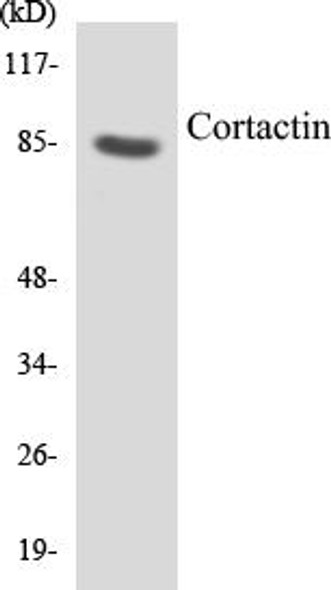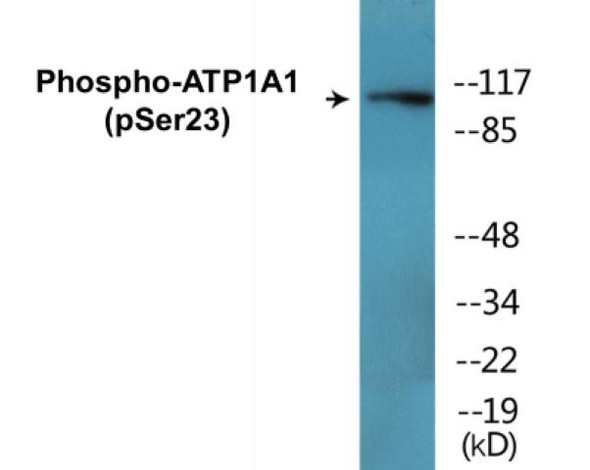Cortactin (Phospho-Tyr421) Colorimetric Cell-Based ELISA Kit
- SKU:
- CBCAB00058
- Product Type:
- ELISA Kit
- ELISA Type:
- Cell Based Phospho Specific
- Research Area:
- Cell Biology
- Reactivity:
- Human
- Mouse
- Rat
- Detection Method:
- Colorimetric
Description
Cortactin (Phospho-Tyr421)Colorimetric Cell-Based ELISA Kit
The Cortactin Phospho-Tyr421 Colorimetric Cell-Based ELISA Kit is specifically designed for the accurate detection of phosphorylated cortactin at the Tyr421 site in cell lysates. This kit offers high sensitivity and specificity, ensuring precise and reliable results for a variety of research applications.Cortactin is a key regulator of actin cytoskeleton dynamics and cell migration, making it essential for processes such as cell adhesion, migration, and invasion. Phosphorylation of cortactin at Tyr421 is known to play a critical role in these cellular processes, making it a valuable biomarker for studying cell signaling pathways and potential therapeutic targets.
With its easy-to-use protocol and robust performance, the Cortactin Phospho-Tyr421 Colorimetric Cell-Based ELISA Kit is an indispensable tool for researchers studying cell signaling mechanisms, cancer metastasis, and other related fields. Upgrade your research with this reliable and advanced ELISA kit today.
| Product Name: | Cortactin (Phospho-Tyr421) Colorimetric Cell-Based ELISA |
| Product Code: | CBCAB00058 |
| ELISA Type: | Cell-Based |
| Target: | Cortactin (Phospho-Tyr421) |
| Reactivity: | Human, Mouse, Rat |
| Dynamic Range: | > 5000 Cells |
| Detection Method: | Colorimetric 450 nm |
| Format: | 2 x 96-Well Microplates |
The Cortactin (Phospho-Tyr421) Colorimetric Cell-Based ELISA Kit is a convenient, lysate-free, high throughput and sensitive assay kit that can detect Cortactin protein phosphorylation and expression profile in cells. The kit can be used for measuring the relative amounts of phosphorylated Cortactin in cultured cells as well as screening for the effects that various treatments, inhibitors (ie. siRNA or chemicals), or activators have on Cortactin phosphorylation.
Qualitative determination of Cortactin (Phospho-Tyr421) concentration is achieved by an indirect ELISA format. In essence, Cortactin (Phospho-Tyr421) is captured by Cortactin (Phospho-Tyr421)-specific primary antibodies while the HRP-conjugated secondary antibodies bind the Fc region of the primary antibody. Through this binding, the HRP enzyme conjugated to the secondary antibody can catalyze a colorimetric reaction upon substrate addition. Due to the qualitative nature of the Cell-Based ELISA, multiple normalization methods are needed:
| 1. | A monoclonal antibody specific for human GAPDH is included to serve as an internal positive control in normalizing the target absorbance values. |
| 2. | Following the colorimetric measurement of HRP activity via substrate addition, the Crystal Violet whole-cell staining method may be used to determine cell density. After staining, the results can be analysed by normalizing the absorbance values to cell amounts, by which the plating difference can be adjusted. |
| Database Information: | Gene ID: 2017, UniProt ID: Q14247, OMIM: 164765, Unigene: Hs.596164 |
| Gene Symbol: | CTTN |
| Sub Type: | Phospho |
| UniProt Protein Function: | Cortactin: a cytoskeletal protein that that is involved in coordinating actin reorganization during cell movement. Localizes at the leading edge of lamellipodia during cell migration. Its amino-terminal acidic domain associates with the Arp2/3 and WASP complex at F-actin branches. The central region of the protein contains six repeats of 37 amino acids that are important in F-actin binding and cross-linking. The carboxy-terminus contains a proline-rich region and an SH3 domain that can interact with numerous scaffolding proteins, such as CortBP1 and Shank3. Cortactin may play a role in the organization of transmembrane receptors at postsynaptic densities (PSD) and tight junctions by linking scaffolding proteins to the actin network. It is degraded in a caspase-dependent manner during apoptosis. It is overexpressed in numerous cancers with poor patient prognosis. It may contribute to tumor cell invasion and metastasis. Two splice variant isoforms have been identified. |
| UniProt Protein Details: | Protein type:Actin-binding; Cytoskeletal; Motility/polarity/chemotaxis Chromosomal Location of Human Ortholog: 11q13 Cellular Component: actin filament; cell cortex; coated pit; cortical cytoskeleton; cytoplasm; cytoskeleton; focal adhesion; Golgi apparatus; growth cone; intracellular membrane-bound organelle; lamellipodium; plasma membrane; ruffle; voltage-gated potassium channel complex Molecular Function:profilin binding; protein binding Biological Process: actin cytoskeleton reorganization; cell motility involved in cell locomotion; focal adhesion formation; intracellular protein transport; neurite morphogenesis; positive regulation of actin filament polymerization; positive regulation of smooth muscle contraction; receptor-mediated endocytosis; regulation of axon extension |
| NCBI Summary: | This gene is overexpressed in breast cancer and squamous cell carcinomas of the head and neck. The encoded protein is localized in the cytoplasm and in areas of the cell-substratum contacts. This gene has two roles: (1) regulating the interactions between components of adherens-type junctions and (2) organizing the cytoskeleton and cell adhesion structures of epithelia and carcinoma cells. During apoptosis, the encoded protein is degraded in a caspase-dependent manner. The aberrant regulation of this gene contributes to tumor cell invasion and metastasis. Three splice variants that encode different isoforms have been identified for this gene. [provided by RefSeq, May 2010] |
| UniProt Code: | Q14247 |
| NCBI GenInfo Identifier: | 215273892 |
| NCBI Gene ID: | 2017 |
| NCBI Accession: | Q14247.2 |
| UniProt Secondary Accession: | Q14247,Q8N707, Q96H99, |
| UniProt Related Accession: | Q14247,AAB26248 |
| Molecular Weight: | 57,467 Da |
| NCBI Full Name: | Src substrate cortactin |
| NCBI Synonym Full Names: | cortactin |
| NCBI Official Symbol: | CTTN |
| NCBI Official Synonym Symbols: | EMS1 |
| NCBI Protein Information: | src substrate cortactin |
| UniProt Protein Name: | Src substrate cortactin |
| UniProt Synonym Protein Names: | Amplaxin; Oncogene EMS1 |
| Protein Family: | CTTNBP2 N-terminal-like protein |
| UniProt Gene Name: | CTTN |
| UniProt Entry Name: | SRC8_HUMAN |
| Component | Quantity |
| 96-Well Cell Culture Clear-Bottom Microplate | 2 plates |
| 10X TBS | 24 mL |
| Quenching Buffer | 24 mL |
| Blocking Buffer | 50 mL |
| 15X Wash Buffer | 50 mL |
| Primary Antibody Diluent | 12 mL |
| 100x Anti-Phospho Target Antibody | 60 µL |
| 100x Anti-Target Antibody | 60 µL |
| Anti-GAPDH Antibody | 60 µL |
| HRP-Conjugated Anti-Rabbit IgG Antibody | 12 mL |
| HRP-Conjugated Anti-Mouse IgG Antibody | 12 mL |
| SDS Solution | 12 mL |
| Stop Solution | 24 mL |
| Ready-to-Use Substrate | 12 mL |
| Crystal Violet Solution | 12 mL |
| Adhesive Plate Seals | 2 seals |
The following materials and/or equipment are NOT provided in this kit but are necessary to successfully conduct the experiment:
- Microplate reader able to measure absorbance at 450 nm and/or 595 nm for Crystal Violet Cell Staining (Optional)
- Micropipettes with capability of measuring volumes ranging from 1 µL to 1 ml
- 37% formaldehyde (Sigma Cat# F-8775) or formaldehyde from other sources
- Squirt bottle, manifold dispenser, multichannel pipette reservoir or automated microplate washer
- Graph paper or computer software capable of generating or displaying logarithmic functions
- Absorbent papers or vacuum aspirator
- Test tubes or microfuge tubes capable of storing ≥1 ml
- Poly-L-Lysine (Sigma Cat# P4832 for suspension cells)
- Orbital shaker (optional)
- Deionized or sterile water
*Note: Protocols are specific to each batch/lot. For the correct instructions please follow the protocol included in your kit.
| Step | Procedure |
| 1. | Seed 200 µL of 20,000 adherent cells in culture medium in each well of a 96-well plate. The plates included in the kit are sterile and treated for cell culture. For suspension cells and loosely attached cells, coat the plates with 100 µL of 10 µg/ml Poly-L-Lysine (not included) to each well of a 96-well plate for 30 minutes at 37°C prior to adding cells. |
| 2. | Incubate the cells for overnight at 37°C, 5% CO2. |
| 3. | Treat the cells as desired. |
| 4. | Remove the cell culture medium and rinse with 200 µL of 1x TBS, twice. |
| 5. | Fix the cells by incubating with 100 µL of Fixing Solution for 20 minutes at room temperature. The 4% formaldehyde is used for adherent cells and 8% formaldehyde is used for suspension cells and loosely attached cells. |
| 6. | Remove the Fixing Solution and wash the plate 3 times with 200 µL 1x Wash Buffer for five minutes each time with gentle shaking on the orbital shaker. The plate can be stored at 4°C for a week. |
| 7. | Add 100 µL of Quenching Buffer and incubate for 20 minutes at room temperature. |
| 8. | Wash the plate 3 times with 1x Wash Buffer for 5 minutes each time. |
| 9. | Add 200 µL of Blocking Buffer and incubate for 1 hour at room temperature. |
| 10. | Wash 3 times with 200 µL of 1x Wash Buffer for 5 minutes each time. |
| 11. | Add 50 µL of 1x primary antibodies Anti-Cortactin (Phospho-Tyr421) Antibody, Anti-Cortactin Antibody and/or Anti-GAPDH Antibody) to the corresponding wells, cover with Parafilm and incubate for 16 hours (overnight) at 4°C. If the target expression is known to be high, incubate for 2 hours at room temperature. |
| 12. | Wash 3 times with 200 µL of 1x Wash Buffer for 5 minutes each time. |
| 13. | Add 50 µL of 1x secondary antibodies (HRP-Conjugated AntiRabbit IgG Antibody or HRP-Conjugated Anti-Mouse IgG Antibody) to corresponding wells and incubate for 1.5 hours at room temperature. |
| 14. | Wash 3 times with 200 µL of 1x Wash Buffer for 5 minutes each time. |
| 15. | Add 50 µL of Ready-to-Use Substrate to each well and incubate for 30 minutes at room temperature in the dark. |
| 16. | Add 50 µL of Stop Solution to each well and read OD at 450 nm immediately using the microplate reader. |
(Additional Crystal Violet staining may be performed if desired – details of this may be found in the kit technical manual.)










